

Applicant shall submit a detailed site plan, to include but not be limited to distance requirements per NFPA, firing method, mortar installation and product being used along with the name of the licensed or pyrotechnic display operator.
Effective Aug. 28, 2004, Missouri State Statue (RSMO. 320.126.4) became law requiring all fireworks displays “shall be supervised, managed, or directed by a Missouri licensed operator or pyrotechnic operator on site”. Operators must be licensed by the Division of Fire Safety.
Assistants – shall be at least 18 years old
Permit applicant shall submit proof of insurance coverage insuring the applicant with liability insurance in order to satisfy claims for damages to property or personal injuries arising out of any act or omission on the part of such person, firm or corporation or any agent or employee thereof with an occurrence limit of not less than $1,000,000.
The licensed pyrotechnic display operator shall have primary responsibility for safety.
Any time fireworks or pyrotechnic materials are on location, they shall not be left unattended or unsecured.
Monitors shall be positioned around the display site to prevent spectators or any other unauthorized persons from entering the display site.
Where required by the Authority Having Jurisdiction (AHJ), approved delineators or barriers shall be used to aid in crowd control.
Get the latest T-SKY Fireworks news, tips, and the lastest products news!

(+86)-18692248999
Weekdays 9:00AM - 5:30PM
4th Floor, No. 24, Huanfu Road, Liuyang City, Hunan Province, China
HELPFULL LINKS